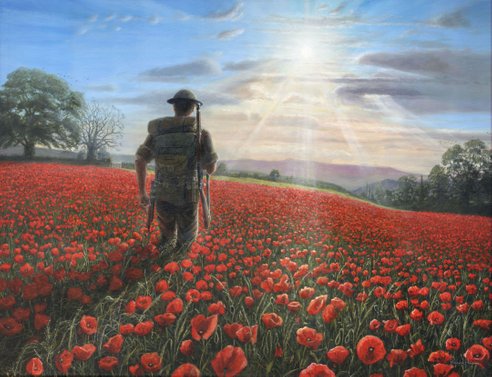Tommy
by Richard Harpum MA
About this Painting
“Tommy” depicts a WW1 soldier wading through a field of poppies in France sometime during the 1914 – 1918 Great War. I was inspired to paint this when I was told by a visitor to my stand at an art show that 2011 was the Royal British Legion’s 90th Anniversary. The visitor saw some of my poppy paintings and suggested that I should donate part of the sale proceeds to the Legion. As an ex-serviceman myself (I spent 11 years in the British Army), I thought that I would go one better and produce a special painting with which to generate funds for the event and possibly for the forthcoming WW1 Centenary.
The original idea for this painting had already come to me when I was watching the 2007 movie “Atonement”, in which there is a brief scene of a soldier walking through a poppy field during the retreat to Dunkirk in 1940. My wife said at the time that this would make a good painting. I decided that in keeping with the British Legion’s anniversary and John McCrae’s famous poem “In Flanders Fields” that inspired the poppy as a symbol of remembrance, a WW1 soldier would be more appropriate.
Most of the painting is created out of my imagination but I carried out extensive research on British Army uniforms from the period and used reference photos of myself for the soldier’s pose, along with others from the extensive photo library I have built up over the years. I also took additional poppy photos in the local fields during June.
I then sketched the overall concept on paper using golden sections (1: 1.618) to position the sun, soldier and various other features.
Because I was making things up as I went along, I made numerous changes. I also added a dead oak tree on the horizon to represent an omen of the possible horrors to come, along with the birds taking flight at the sight of Tommy.
My hope is that this painting will be thought-provoking. It is my intent to leave it to the observer to ponder where Tommy may be heading and whether he is advancing or retreating. I also hope that it will remind people of the horrors of war and of the importance of remembering those who have made the ultimate sacrifice.
In Flanders Fields
By John McCrae, May 1914
In Flanders fields the poppies blow
Between the crosses, row on row,
That mark our place; and in the sky
The larks, still bravely singing, fly
Scarce heard amid the guns below.
We are the Dead. Short days ago
We lived, felt dawn, saw sunset glow,
Loved and were loved, and now we lie
In Flanders fields.
Take up our quarrel with the foe:
To you from failing hands we throw
The torch; be yours to hold it high.
If ye break faith with us who die
We shall not sleep, though poppies grow
In Flanders fields.
Size of original: 30" x 40" (76cm x 102cm)
Acrylic on Canvas
Painting Reference Number: 168
Buy a Limited Edition Print:
- Pay via PayPal (press "Add to Cart" button above - no account needed)
- Contact the Artist by e-mail >>>>
- Contact the Artist by 'phone: +44 7710 009500 or +44 1302 759272
Buy an open edition print: Click Here >>>>
Original Sold
Prices of Limited Edition Prints (numbered, signed, unframed):
- Studio Proof** canvas print (full size); Edition size 25: £720; US$1,180; €900 + shipping
- Studio Proof** canvas print (15.5" x 20"); Edition size 50: £299; US$493; €399 + shipping
- Giclée print*** on 300 gsm paper (full size): Edition size 50: £360; US$594; €450 + shipping
* Prices in US Dollars and Euros are those used by the artist but may vary depending upon the prevailing exchange rates and the method of payment.
** A Studio Proof canvas print is a giclée print on canvas that is hand-embellished by the artist using the same medium as the original painting (usually acrylic), signed, numbered and then coated in 3 layers of UV-resistant varnish. It is then mounted on stretchers ready for framing.
*** Giclée printing is an advanced form of ink jet printing that applies a wide range of coloured inks that are designed to be light-fast for at least 75 years.
Copyright © Richard Harpum

